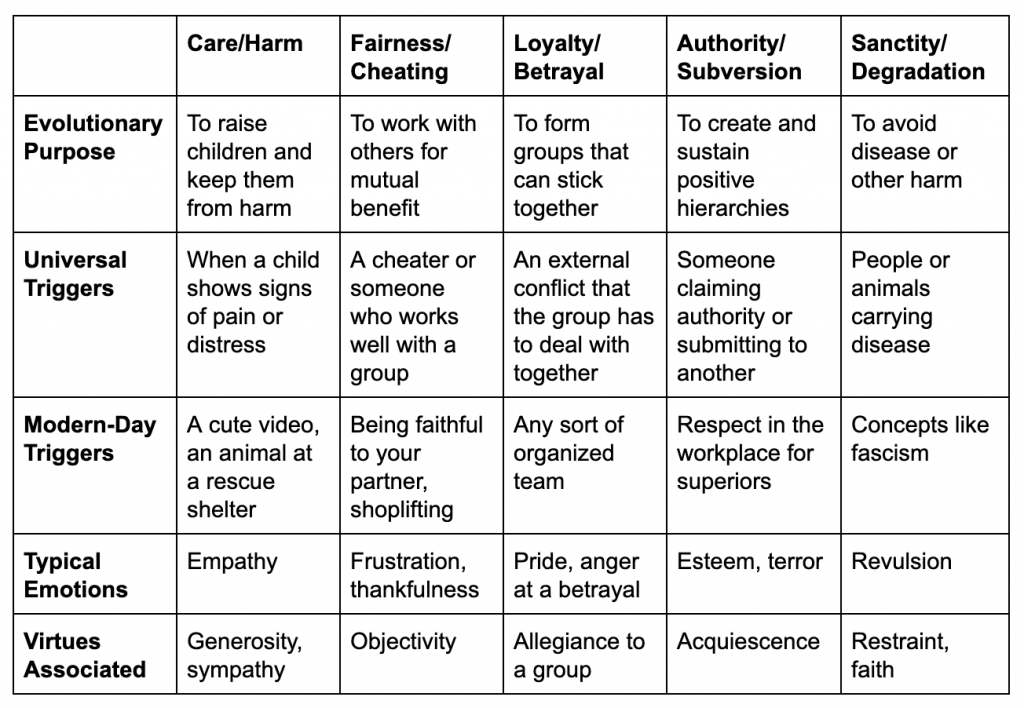

This article is an excerpt from the Shortform book guide to "The Righteous Mind" by Jonathan Haidt. Shortform has the world's best summaries and analyses of books you should be reading.
Like this article? Sign up for a free trial here .
What is Jonathan Haidt’s Moral Foundations Theory? What does he believe are the six foundations of morality?
Jonathan Haidt’s Moral Foundations Theory puts forth six foundations of morality that we all have, but in different proportions. They are based on how people in various cultures deal with life’s challenges and what they regard as virtues.
Read more to learn about Haidt’s Moral Foundations Theory.
The First Five Foundations of Morality
Jonathan Haidt’s Moral Foundations Theory is based on his examination of normal social life and the challenges associated with it around the world. He considered how people in different cultures deal with these challenges differently, and what they prioritize as virtues.
In his research, Haidt found five foundations of morality, or “taste receptors.” Just as we all have the same five taste receptors but prefer different foods, we all have these same five moral foundations, but in different proportions. The foundations are:
- Care/harm
- Fairness/cheating
- Loyalty/betrayal
- Authority/subversion
- Sanctity/degradation
Each foundation has an adaptive advantage—in some way, each one helped humans succeed. Each also has triggers that existed generations ago and triggers that exist today. Finally, each foundation is associated with certain emotions and virtues. Find the characteristics of each foundation, or “taste receptor,” in the table below.

Haidt’s Moral Foundations Theory did not include the sixth foundation, Liberty/oppression, until he discovered it later.
To understand how the foundations work in practice, we’ll use an example of the Care/harm principle: You take your four-year-old to a hospital to have his appendix removed. You can watch through a glass wall, and you see him lying on the operating table unconscious while the surgeon punctures his abdomen. You might feel both relief knowing the doctor is saving his life and pain watching him get punctured. From Jeremy Bentham’s utilitarian point of view, it would be irrational if you looked away in fear because you know the doctor is not harming your child. But from the point of view of Haidt’s “taste receptor” theory, it makes sense, because you have an emotional response to watching your child bleed, even though you know rationally the doctor is not committing violence on him. This shows that you are caring and empathetic and that the Care/harm principle is a powerful “taste receptor” for you.
Discovering the Sixth Foundation
Haidt began to conduct experiments and write opinions based on his five principles, he realized that liberals and conservatives understood the second principle, Fairness/cheating, differently. Liberals argued that conservatives don’t care about fairness because they don’t care about equal outcomes—for example, they don’t care whether every school district is equally well-funded. However, conservatives also argued that liberals don’t care about fairness in this case because they don’t care about proportional outcomes—for example, they don’t care that successful people have to pay a lot of their hard-earned money in taxes. Haidt realized that he needed a better definition of fairness, and with it a better definition of equality. This led him to create a sixth taste receptor.
The Sixth Foundation of Morality
The Fairness foundation is rooted in the wish to protect communities from cheaters, while the new foundation, Liberty/oppression, is about protecting society from cheaters. Fairness/cheating is about reciprocity, while Liberty/oppression is about a broader definition of equality.
Haidt’s Moral Foundations Theory states that the Liberty/oppression foundation rests on human nature. There are wide differences between philosophers’ understanding of basic human nature, but it’s clear that in every “state of nature,” some humans want to dominate others. When humans band together, it’s to protect each other from tyranny and also to select away from the people who would choose to dominate or bully others.
The original trigger of the Liberty/oppression matrix is domination and tyranny. People get angry when they feel controlled, which can lead to a reactance—when an authority figure tells you to do something and you become interested in doing the opposite. People band together to stop this domination and can resist or even sometimes kill the oppressor. Biologically, people who couldn’t recognize this kind of oppression coming were less likely to thrive.
The Liberty foundation exists in some tension with the Authority foundation. We do recognize authority as sometimes legitimate (the Authority foundation), but we’re vigilant about authority and want our authority figures to earn our trust (the Liberty foundation). Read any declaration of independence from a colonial state, including America’s, and you’ll see signs of this foundation. It lists oppressive events and enumerates rights that a revolution will secure.
Oppression concerns both liberals and conservatives, and they express this concern in unique ways.
- Liberals employ the Liberty/oppression foundation when arguing on behalf of traditional underdogs. They worry that the accumulation of wealth by the top 1% will lead to oppression, and they fight for civil rights and human rights. Sometimes people further to the left also fight for equal outcomes, or an equality of pay and services rendered no matter your job title, which doesn’t exist in capitalist systems.
- Conservatives are more concerned about their own groups than humanity as a whole. They say, “Don’t tread on me with high taxes, my business with regulations, or my nation with the UN and international treaties.”
Conservatives care much more about the word liberty than they do equality. Consider Liberty University, founded by evangelical preacher Jerry Falwell. Liberty University’s students are pro-authority and pro-traditional family, but they oppose control or authority from the government.
You can find a deeper discussion of Haidt’s Moral Foundations Theory in his book The Righteous Mind.

———End of Preview———
Like what you just read? Read the rest of the world's best book summary and analysis of Jonathan Haidt's "The Righteous Mind" at Shortform .
Here's what you'll find in our full The Righteous Mind summary :
- Why we all can't get along
- How our divergent moralities evolved
- How we can counter our natural self-righteousness to decrease political divides






